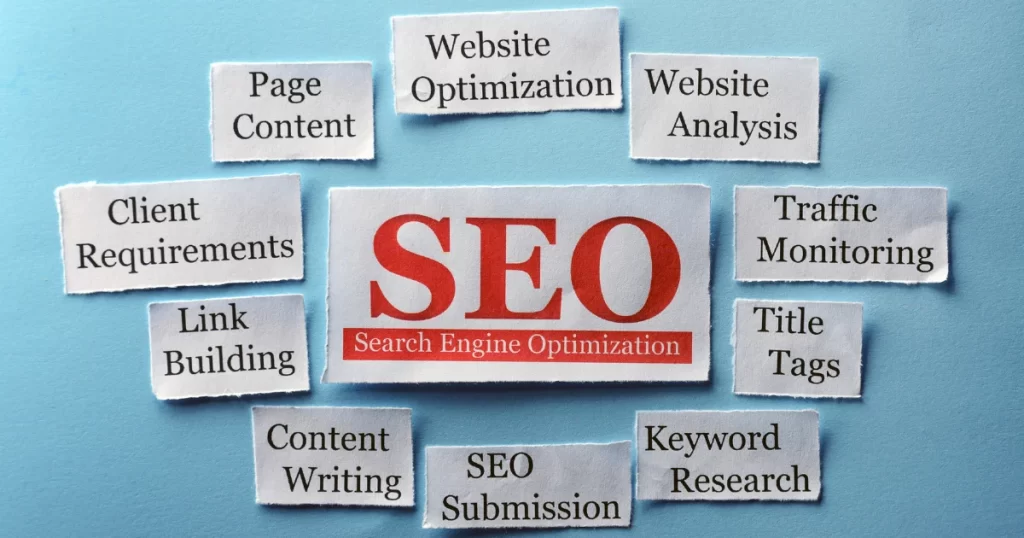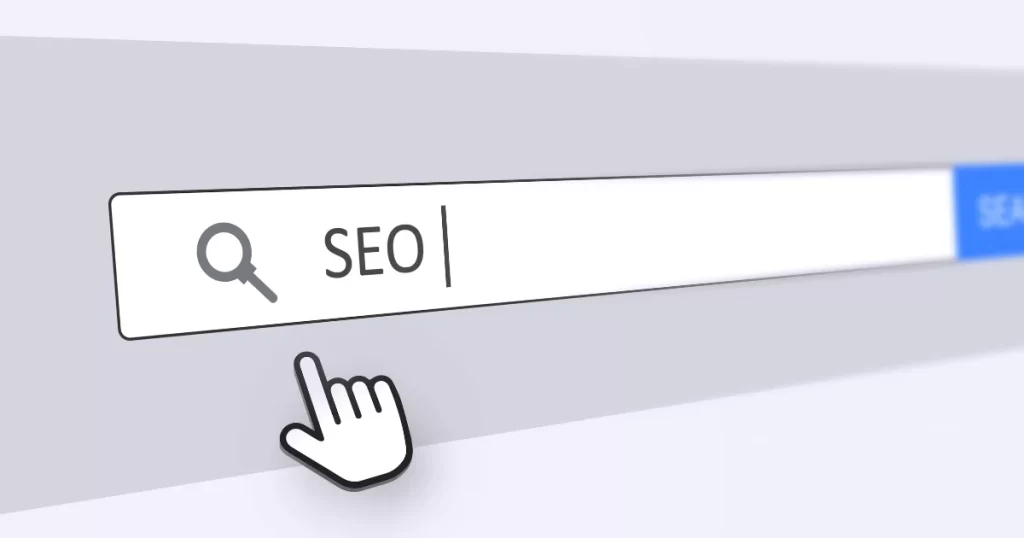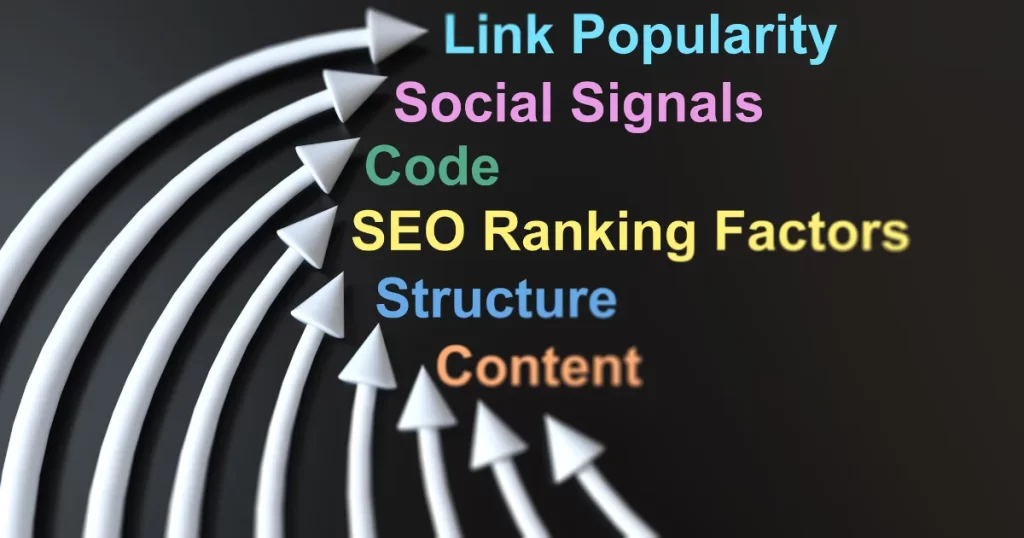Search Engine Optimization (SEO) is a must-have skill for bloggers seeking to boost visibility and reach a larger audience. Implementing effective SEO practices ensures that your blog ranks high in search engine results, drawing in more organic traffic and boosting reader engagement. This guide is crafted to help bloggers understand, apply, and master SEO fundamentals to maximize their blog’s potential.
In this guide, you’ll learn:
- The basics of SEO and how search engines work
- How to conduct impactful keyword research
- Key strategies for on-page optimization
- Techniques for link building, technical SEO, and performance monitoring
- Tips for adapting your SEO strategy based on data and trends
Let’s dive in and make your blog more discoverable and impactful!
Understanding SEO

What is SEO?
Search Engine Optimization (SEO) is the process of improving a blog or website’s visibility on search engines like Google. In simple terms, SEO ensures that search engines can find, index, and rank your content so it appears in relevant search results. The goal is to attract more organic (unpaid) traffic, increasing the chances of reaching and engaging a target audience.
“SEO is not about gaming the system; it’s about creating valuable content and building a website that truly benefits your readers.”
– Brian Dean, SEO Expert
SEO involves several key processes that determine a site’s visibility:
- Crawling: Search engines deploy automated bots, or “crawlers,” to scan websites across the internet. These bots analyze the content on each webpage, looking at text, images, links, and other elements to understand what each page is about.
- Indexing: After crawling, the search engine compiles the data from each scanned page and adds it to an extensive database or index. This index is where search engines retrieve results whenever a user enters a query.
- Ranking: When a user searches for a topic, the search engine pulls relevant pages from its index, ranking them based on various factors, including relevance, quality, and user experience.
Understanding these processes is essential for bloggers because each phase of SEO impacts visibility. Content that is easily crawled and well-organized is more likely to be indexed quickly. Quality content with optimized keywords, a logical structure, and helpful information has a higher chance of ranking well.
Key Components of SEO
The basic components of SEO are what guide a blogger’s approach to creating and structuring their content. Here’s a quick breakdown of these elements:
| Component | Definition | Why It Matters for Bloggers |
|---|---|---|
| Crawling | Bots (crawlers) scan webpages to discover new or updated content. | Ensures that your blog posts are recognized and understood by search engines. |
| Indexing | Process of storing and organizing content discovered by crawlers into a database. | Indexed content is more accessible to users through search engine queries. |
| Ranking | Determining the order of search results based on various factors like relevance and quality. | Higher rankings increase your blog’s visibility, leading to more organic traffic. |
| Organic Traffic | Unpaid, naturally occurring website visits derived from search engine results. | Sustainable traffic source that builds credibility and trust with the audience. |
| Paid Traffic | Visits generated by advertisements displayed within search engine results. | Although effective, it’s temporary and depends on ad budget rather than content quality. |
Organic Vs. Paid Search Results
In search engine results, you’ll notice a mix of organic and paid listings. Organic results are those that earn their spot naturally, based on relevance and the effectiveness of SEO practices, without any direct advertising costs. These results are particularly important for bloggers because they reflect genuine interest from readers who find the content valuable. Conversely, paid search results are advertisements placed at the top or bottom of search engine result pages (SERPs) and are marked as “Ad.”
Focusing on organic traffic offers sustainable benefits for bloggers. Unlike paid traffic, organic visitors are often more interested in what you have to offer since they found your site based on a specific search rather than a paid promotion. Organic traffic also builds credibility and long-term trust with your audience.
Why SEO is Essential for Bloggers
For bloggers, SEO is not just a tool but a necessity to reach the right audience and increase visibility. While content quality is critical, even the most engaging articles can go unnoticed without effective SEO. Here are a few reasons why:
- Improved Discoverability: SEO helps your blog become more discoverable to readers searching for topics you cover. This means your posts have a better chance of being read, shared, and bookmarked.
- Enhanced User Experience: Good SEO practices, like optimizing page speed and mobile-friendliness, directly improve the user experience, which Google considers when ranking pages.
- Builds Authority: Over time, high-quality, optimized content can establish your blog as an authority in its niche, attracting even more traffic and opportunities for backlinks.
- Increases Engagement: SEO encourages bloggers to structure content clearly with relevant keywords, headers, and images, which helps keep readers engaged and encourages them to spend more time on the blog.
By focusing on SEO, bloggers position themselves to receive a steady stream of interested readers, creating a foundation for long-term success.
Keyword Research

Keyword research is the backbone of SEO. When you identify and target the right keywords, your content becomes more relevant to what users are actively searching for, giving your blog posts a better chance of ranking higher on search engine results pages (SERPs). With effective keyword research, bloggers can hone in on topics that resonate with readers and align with search engine algorithms.
Types of Keywords: Short-Tail vs. Long-Tail
Understanding the differences between short-tail and long-tail keywords is crucial to creating a well-rounded SEO strategy. Both types serve specific purposes and target different search intents:
- Short-Tail Keywords:
These are broad, often highly competitive keywords. Typically consisting of one to two words, examples include terms like “SEO,” “blogging,” or “content marketing.” While these keywords have high search volumes, they’re more challenging to rank for because they attract a vast audience. Short-tail keywords are ideal if you’re aiming for high visibility, but they might not always convert well since they lack specificity. - Long-Tail Keywords:
These are longer, more specific phrases, such as “SEO strategies for beginners” or “how to optimize a blog post for SEO.” Long-tail keywords generally have lower search volume but are highly relevant to a specific search intent, which can make them easier to rank for. Long-tail keywords allow bloggers to attract a niche audience actively looking for detailed information or solutions to particular problems. For instance, a blog post targeting “SEO strategies for beginners” will likely attract readers specifically interested in beginner-friendly SEO tips.
Why Long-Tail Keywords Matter for Bloggers
For bloggers, long-tail keywords are essential. They allow you to reach a highly targeted audience and align your content with specific queries, increasing the likelihood that your posts will rank well. By focusing on long-tail keywords, bloggers can achieve better relevance and connect more effectively with readers looking for niche content. Additionally, long-tail keywords often reflect the exact language users input into search engines, making your content more accessible and tailored to reader expectations.
Tools for Keyword Research
Several tools can help bloggers find and evaluate keywords that suit their SEO goals. Each tool offers unique insights, from search volume and competition to competitor analysis and keyword difficulty. Here are a few of the most popular keyword research tools for bloggers:
| Tool | Features | Best For |
|---|---|---|
| Google Keyword Planner | Provides search volume, competition level, and keyword suggestions. | Beginners; it’s free and user-friendly. |
| Ahrefs | Offers in-depth analysis of keyword difficulty, related keywords, and backlink opportunities. | Comprehensive analysis for serious bloggers who want advanced insights. |
| SEMrush | Tracks keyword ranking, search volume, and competitive analysis on a global scale. | Competitor analysis and identifying gaps in content coverage. |
| Ubersuggest | Free option for keyword suggestions, SEO audit, and site analysis. | Bloggers looking for a simple, free tool for basic research and inspiration. |
| Moz Keyword Explorer | Helps with finding keyword opportunities, SERP analysis, and tracking keyword performance over time. | Bloggers who want ongoing insights on keyword performance. |
Each tool provides data to help you make informed decisions, from which keywords to target to how competitive each one is. Using these tools helps streamline the keyword research process and enables bloggers to create content that aligns with high-value keywords.
Step-by-Step Keyword Strategy
Creating an SEO keyword strategy involves more than simply picking high-traffic keywords. It requires a structured approach to identify and prioritize keywords that bring in the right audience. Below is a step-by-step guide to crafting an effective keyword strategy:
| Step | Description |
|---|---|
| Step 1: Identify Topics | Brainstorm topics that resonate with your target audience. For example, if your blog focuses on SEO, potential topics could include “SEO basics,” “SEO for beginners,” or “SEO tips for bloggers.” |
| Step 2: Generate Keywords | Use keyword research tools to generate a list of keywords related to each topic. Explore both short-tail and long-tail options to maximize reach and relevance. |
| Step 3: Analyze Competition | Look at the competition level for each keyword. High-competition keywords can be challenging to rank for, so consider balancing them with lower-competition options that still have decent search volume. |
| Step 4: Select Target Keywords | Choose a combination of high-traffic and low-competition keywords, focusing on long-tail keywords for more targeted reach. This mix provides broader coverage and better ranking potential. |
Tips for Building a Focused Keyword Strategy
A strong keyword strategy increases your blog’s visibility by aligning your content with what readers are searching for. Here are some tips to help you create a focused and effective keyword strategy:
- Understand Your Audience: Knowing your audience is key to identifying relevant keywords. Consider what problems they are trying to solve and how they might phrase those questions.
- Balance Between Search Volume and Competition: High-volume keywords are valuable, but they’re often harder to rank for. Low-competition keywords, especially long-tail keywords, may have lower search volume, but they can drive highly targeted traffic.
- Aim for User Intent: Keywords should match the intent of your audience. For example, if users are looking for “beginner SEO tips,” a blog post on that topic will serve them better than a general article on SEO.
- Use Keywords Naturally: While integrating keywords is essential, keyword stuffing can harm readability and affect your SEO. Aim for a natural flow where keywords enhance rather than disrupt the user experience.
By following these steps and tips, bloggers can implement a keyword strategy that aligns with SEO best practices, drives relevant traffic, and helps their content reach the right audience.
On-Page Optimization

On-page SEO refers to the steps taken to enhance individual blog posts for search engines, focusing on structuring, formatting, and optimizing content. By fine-tuning on-page elements, you make your posts more accessible and attractive to both search engines and readers, increasing the likelihood of ranking higher in search results. Let’s explore the core aspects of on-page SEO that help ensure blog content is readable, engaging, and well-suited for search engine algorithms.
Key Elements of On-Page SEO
- Titles and Headings: Titles and headings are essential to any blog post because they help define the structure and flow of your content, making it more digestible for readers and search engines alike. An effective title grabs attention, summarizes the post, and includes the primary keyword—here, “SEO.”
- Primary Keyword Integration: The title should contain the main keyword, e.g., “SEO for Bloggers.” This signals relevance to search engines and makes it clear to readers what the post is about.
- Subheadings (H2, H3, H4): Structuring content with subheadings not only improves readability but also helps Google understand the hierarchy and context of your content. Subheadings like “Key Elements of On-Page SEO” or “Content Optimization Tips” break down information and allow you to weave in additional keywords or related phrases naturally.
- Meta Descriptions: Meta descriptions are the short snippets of text that appear under your blog’s link in search engine results. A well-crafted meta description provides a concise summary of your post’s content and entices users to click through.
- Keyword Usage: Including the primary keyword in the meta description enhances its relevance in search results.
- Compelling Summary: Aim to be clear and engaging within the 150-160 character limit. For instance, “Learn top SEO tips for optimizing your blog content, from titles to images,” provides a quick and inviting overview.
- Content Optimization: Optimizing content with SEO best practices means using keywords strategically without overloading the text, also known as keyword stuffing. This process ensures that the content feels natural and is enjoyable for readers while remaining optimized for search engines.
- Primary Keyword Placement: Place your primary keyword in the introduction, subheadings, and conclusion.
- Related Keywords: Use secondary keywords or synonyms throughout the content to improve context. For example, if “SEO for bloggers” is the main keyword, related keywords might include “SEO basics” or “SEO tips for content creators.”
- Internal Linking: Linking to other posts on your blog enhances user navigation and gives search engines more context about your site’s structure.
| On-Page SEO Element | Purpose | Optimization Tip |
|---|---|---|
| Title | Attracts clicks and includes the primary keyword | Include the primary keyword at the start if possible; make it concise and compelling. |
| Meta Description | Summarizes content in search results | Use 150-160 characters, include the main keyword, and provide a compelling reason to click. |
| Subheadings | Improves readability and SEO structure | Include relevant keywords in H2, H3, and H4 tags to improve SEO and enhance readability. |
| Keyword Usage | Increases relevance of content | Place keywords naturally in the content, avoiding stuffing, and use related keywords for added context. |
| Internal Linking | Enhances site navigation and SEO | Link to other relevant blog posts to boost engagement and assist in indexing related content. |
Using Images and Alt Text
Visual content, like images, can enrich blog posts and make them more engaging. However, it’s essential to optimize images for SEO to ensure they contribute positively to search rankings. Optimized images load faster, are more accessible, and provide additional signals to search engines about the content’s subject.
- File Names:
Before uploading images, rename them to include descriptive keywords. Instead of a default file name like “IMG1234.jpg,” rename the image to something relevant, like “SEO-blog-tips.jpg.” This small step provides context for search engines when they index your images, especially in image searches. - Alt Text (Alternative Text):
Alt text is a brief description of an image, and it serves multiple purposes. It improves accessibility for visually impaired users by describing the image, and it also gives search engines more information about the content.- Keyword Inclusion: Use relevant keywords naturally within alt text without keyword stuffing. For instance, if you’re discussing SEO tips for beginners and include an infographic, the alt text could be, “Infographic illustrating essential SEO tips for new bloggers.”
- Conciseness: Aim to be specific and concise, ideally within a sentence or two. Avoid redundant phrases like “image of” or “photo of.”
| Image Optimization Element | Purpose | Optimization Tip |
|---|---|---|
| File Names | Provides context to search engines | Rename image files to include descriptive keywords, e.g., “SEO-tips-for-beginners.jpg.” |
| Alt Text | Improves accessibility and SEO | Write concise, descriptive alt text that naturally includes a keyword relevant to the post. |
By following these on-page SEO practices, bloggers can make their content more visible to search engines while providing a better experience for their readers. Optimizing elements like titles, meta descriptions, content structure, and images creates a solid foundation for SEO success.
Content Quality and Strategy

Content quality forms the foundation of any successful SEO approach. Google’s algorithms are increasingly adept at recognizing and rewarding content that offers true value to users, prioritizing blog posts that are informative, engaging, and genuinely beneficial. Creating quality content not only improves search engine rankings but also builds a loyal audience, as readers find your content valuable and are likely to return.
“Quality content is the backbone of successful SEO. It’s what engages, informs, and ultimately retains your audience.”
– Rand Fishkin, Founder of SparkToro
Characteristics of High-Quality Content
- Relevance
Creating relevant content means directly addressing the questions, concerns, or needs of your audience. A blog post optimized for SEO should answer queries your readers are likely to search for. Researching popular questions within your niche is key to ensuring relevance.- Audience Insight: Understanding your target audience helps tailor content to their needs. For instance, if your blog focuses on digital marketing, creating posts on topics like “SEO for Small Businesses” or “Top Content Marketing Trends” can resonate with readers looking for specific advice.
- Comprehensiveness
High-quality content isn’t just informative; it’s comprehensive. Rather than offering a surface-level answer to a question, aim to explore topics in-depth to provide real value. When readers can find all the information they need in one place, they’re more likely to engage and spend more time on the page, both of which contribute to positive SEO signals.- In-Depth Guides: For instance, a post on “SEO Best Practices” could cover multiple aspects like keyword research, content optimization, link-building strategies, and tracking results.
- Subtopics: Breaking down complex topics into smaller, digestible sections (with subheadings) helps readers find what they need quickly and makes your content more structured.
- Engagement
Structuring content for visual appeal and ease of reading is crucial to keeping readers interested. By incorporating various elements like headings, bullet points, and images, you can make content more engaging, encourage readers to stay on the page longer and reduce bounce rates, which can improve SEO.- Readable Formatting: Breaking content into short paragraphs, using bullet points, and adding images or infographics enhances readability.
- Interactive Elements: Embedding elements like videos, infographics, or tables can help capture attention and keep readers engaged.
| Content Quality Element | Purpose | Optimization Tip |
|---|---|---|
| Relevance | Addresses reader needs | Conduct audience research to determine questions and pain points within your niche. |
| Comprehensiveness | Provides in-depth information | Cover all aspects of a topic to create a thorough resource that answers multiple related questions. |
| Engagement | Keeps readers on the page and reduces bounce rates | Use short paragraphs, bullet points, images, and other elements to create an engaging reading experience. |
Creating a Cohesive Content Strategy
Developing a content strategy that aligns with SEO goals helps ensure your blog posts are interconnected, enabling readers to explore more of your content. A cohesive strategy means planning content around a central theme or set of themes, optimizing each post for both relevance and structure and linking related posts together.
- Content Planning
Planning content with SEO in mind allows you to build a network of related posts, each focusing on specific keywords. This strategy not only strengthens your blog’s structure but also signals to search engines that your site covers topics comprehensively.- Keyword Clusters: Organize related keywords around a central topic. For example, if your main topic is SEO, you might create clusters on “SEO for Beginners,” “On-Page SEO Techniques,” and “Advanced SEO Strategies.”
- Content Calendar: Maintain consistency by planning topics in advance. Consistent posting signals to Google that your site is active, which can have positive implications for ranking.
- Interlinking Content
Connecting related posts through internal links not only helps readers discover more of your content but also spreads SEO value across your site. By linking to other relevant blog posts, you help search engines understand your site’s structure, which can improve indexing and ranking.- Anchor Text: Use descriptive anchor text that includes keywords when linking to related posts. For instance, a blog on “SEO Content Strategy” could link to a post on “Keyword Research for SEO” with anchor text like “learn more about effective keyword research.”
- Topic Hierarchy: Link foundational posts (like “Introduction to SEO”) to more specific or advanced topics (like “SEO for E-commerce Sites”) to create a structured information flow.
- Updating Content
Regularly updating older posts with new insights, data, or relevant changes in the industry keeps your content fresh and relevant. Google values updated content as it signals that your site provides current and reliable information.- Adding New Information: Revisit older posts and add updated statistics, fresh examples, or new insights.
- Content Refreshes: Review posts every 6-12 months to keep them relevant to current trends or algorithm updates.
| Content Strategy Element | Purpose | Optimization Tip |
|---|---|---|
| Keyword Clusters | Organizes content by related keywords | Group content topics by relevance, creating a cluster of posts around central themes like SEO strategies. |
| Interlinking | Connects related posts and aids site navigation | Use keyword-rich anchor text and link to related posts to improve user navigation and SEO relevance. |
| Content Updates | Keeps information current and relevant | Regularly refresh older content to maintain relevance and high-quality standards. |
Link Building

Link building is a critical part of SEO that involves acquiring links from reputable sites to boost your blog’s authority. These backlinks serve as endorsements from other sites, indicating to search engines that your blog is a credible and valuable resource. Effective link-building takes time and effort, but it plays a significant role in developing your blog’s visibility and authority within your niche.
Why Backlinks Matter
Backlinks are one of the most influential factors in how search engines rank your content. Here’s why they matter:
- Boost Domain Authority
Search engines like Google view backlinks as a sign of credibility and trustworthiness. A site with a higher domain authority is more likely to rank well, as search engines perceive it as an authoritative source. - Drive Referral Traffic
Backlinks from reputable websites can send readers directly to your blog, driving relevant traffic and increasing the chances of attracting new readers who are interested in your niche. - Enhance Content Credibility
High-quality backlinks signal to search engines that your content is trustworthy. If reputable sites are linking to your blog, it reinforces the quality and relevance of your content, increasing your chances of ranking higher for your targeted keywords.
Link-Building Strategies for New Bloggers
Building quality backlinks takes consistent effort and strategy. Here are some effective link-building methods:
- Guest Blogging
Guest blogging involves contributing articles to other blogs within your niche. Not only does it provide exposure to new audiences, but it also allows you to link back to your own blog. When reaching out for guest blogging opportunities, prioritize blogs with a similar audience and strong domain authority.- How to Approach: Look for blogs in your niche that accept guest posts, and pitch unique ideas that align with their content. Include links to your own posts as additional resources.
- Tip: Use a natural, relevant anchor text when linking back to your content in the guest post.
- Outreach
Outreach involves connecting with bloggers, influencers, or site owners to request backlinks. The idea is to build genuine relationships by engaging with other content creators in your niche. Personalize your outreach emails and explain how linking to your blog can benefit their readers.- Effective Outreach Tips:
- Research the person or website you’re reaching out to and reference specific posts.
- Offer something in return, like a mention or link on your blog.
- Be respectful and concise in your communication.
- Effective Outreach Tips:
- Resource Pages
Many websites maintain resource pages or lists that link to valuable content. Finding these pages within your niche and suggesting your blog as a resource can be an effective way to gain backlinks.- Finding Resource Pages: Use search terms like “Your Topic + resources” or “Your Topic + helpful links” to find these lists.
- Pitching Tips: Clearly state why your content would be a valuable addition to their resource page and link to specific posts that match their audience’s interests.
- Broken Link Building
Broken link building involves identifying broken links on other websites and suggesting your blog as an alternative link. This approach provides a helpful solution to site owners while earning you a valuable backlink.- Steps:
- Use tools like Ahrefs or Check My Links to find broken links on related sites.
- Reach out to the site owner, notifying them of the broken link and offering your own blog post as a replacement.
- Steps:
- Creating Link-Worthy Content
Creating high-quality, unique content that stands out in your niche increases the chances of others linking to it. Original research, infographics, how-to guides, or comprehensive tutorials can naturally attract backlinks.- Linkable Content Ideas: Infographics, case studies, and ultimate guides are often highly shareable and linkable.
- Promote Your Content: Share your link-worthy content on social media and with your network to increase its reach and likelihood of earning backlinks.
Additional Tips for Effective Link Building
- Focus on Quality, Not Quantity: A few high-quality backlinks from reputable sites are more valuable than numerous links from low-authority sources.
- Use Anchor Text Strategically: Make sure your anchor text is descriptive and relevant, as this helps search engines understand the context of the link.
- Build Relationships: Networking with bloggers and influencers in your field can lead to more organic link-building opportunities over time.
- Monitor Backlinks: Tools like Ahrefs or Google Search Console help you track your backlinks and see which strategies are most effective.
Link building is a crucial part of SEO, helping you establish credibility, improve rankings, and drive traffic. By implementing strategies like guest blogging, outreach, and creating link-worthy content, you’ll be on the path to building a stronger online presence and achieving long-term SEO success.
Technical SEO Requirements

Technical SEO plays a vital role in making sure that search engines can easily find, crawl, and index your blog’s content. These requirements ensure that your blog remains user-friendly and fully accessible to search engines, directly impacting your SEO rankings. Technical SEO also has a significant influence on user experience, which indirectly affects your SEO performance, as a seamless user experience can lead to lower bounce rates and increased engagement.
Key Technical SEO Factors
Understanding the critical factors in technical SEO helps optimize your blog for both users and search engines. Here are the core elements to focus on:
- Site Speed
Page speed is essential for both user experience and SEO rankings. Google prioritizes fast-loading websites, as they enhance the user experience by reducing waiting times. A faster site is also less likely to frustrate visitors, potentially reducing bounce rates and increasing engagement.- Improvement Tips: Compress images, enable browser caching, and use a content delivery network (CDN) to serve your content more quickly to visitors across different regions.
- Recommended Tool: Google PageSpeed Insights helps analyze and provide recommendations for improving page speed.
- Mobile Responsiveness
With more users browsing on mobile devices, it’s crucial for your blog to be mobile-friendly. Google’s mobile-first indexing means that it primarily uses the mobile version of your site for ranking and indexing. A responsive design ensures your site adapts to various screen sizes and provides a seamless experience across devices.- Mobile Optimization Tips: Use responsive design elements, avoid pop-ups that block content, and ensure buttons are easy to tap on smaller screens.
- Testing Tool: Google’s Mobile-Friendly Test checks if your site is optimized for mobile users.
- URL Structure
Clean, descriptive URLs are easy for both users and search engines to understand. Short, clear URLs provide a better user experience and help search engines interpret the page content, which is essential for SEO.- Best Practices: Include your primary keyword in the URL, avoid unnecessary numbers or symbols, and keep URLs as concise as possible.
- Example: Instead of a URL like “myblog.com/post?id=12345,” use a format like “myblog.com/seo-guide.”
- Sitemaps
A sitemap is a file that provides search engines with a map of your blog’s content, helping them discover and index all the pages on your site. An XML sitemap is essential for technical SEO and is especially beneficial for larger blogs with many pages.- Importance: A well-structured sitemap ensures search engines can crawl your site more effectively.
- Generating a Sitemap: Use tools like Yoast SEO (if using WordPress) or standalone sitemap generators to create and manage your sitemap.
- Robots.txt File
The robots.txt file is a guide for search engines on which pages of your site they can and cannot crawl. This file helps control crawler activity, preventing them from indexing pages you don’t want to appear in search results, like admin pages.- Usage Tip: Ensure that the robots.txt file isn’t blocking any critical pages by mistake, as this could prevent important pages from being indexed.
| Technical SEO Factor | Description | Importance |
|---|---|---|
| Page Speed | Faster loading times improve user experience and reduce bounce rates. | Improves rankings and enhances user experience. |
| Mobile Optimization | Adapts the site for mobile devices, essential for mobile-first indexing. | Expands reach to mobile users. |
| URL Structure | Clean URLs that are easy to understand for both users and search engines. | Enhances readability and searchability. |
| Sitemap | Provides search engines with a map of your site’s structure. | Ensures pages are easily found and indexed. |
| Robots.txt File | Manages search engine crawler behavior to optimize crawl efficiency. | Prevents unwanted pages from being indexed. |
Monitoring Performance in Technical SEO
Once your technical SEO is in place, monitoring its performance is essential to track the effectiveness of your optimizations and identify areas for improvement. Below are some critical metrics to keep an eye on:
- Organic Traffic
Organic traffic refers to the number of visitors arriving on your site from search engine results pages (SERPs). Tracking this metric helps you understand if your SEO efforts are attracting more visitors to your blog. Consistent increases in organic traffic indicate successful optimizations.- Tracking Tool: Google Analytics shows detailed insights on organic traffic sources.
- Bounce Rate
Bounce rate is the percentage of users who leave your blog after viewing only one page. A high bounce rate may indicate issues with content relevance or technical aspects like page speed. A lower bounce rate suggests users are engaging more with your content, which is favorable for SEO.- Improvement Tips: Ensure your content is engaging, relevant to your audience, and that page speed is optimized.
- Conversion Rate
Conversion rate measures the percentage of visitors who complete a desired action, such as signing up for a newsletter, downloading a resource, or making a purchase. High conversion rates reflect well-optimized pages that successfully lead visitors to take action.- Tracking Tools: Google Analytics allows you to set up goals to monitor conversions and track user interactions on your blog.
- Crawl Errors
Crawl errors occur when search engines cannot access certain pages on your site, hindering them from indexing your content. Monitoring for crawl errors allows you to promptly fix any issues that may prevent search engines from fully understanding your site.- Tool: Google Search Console helps identify and troubleshoot crawl errors.
- Core Web Vitals
Core Web Vitals are a set of metrics that assess your website’s loading performance, interactivity, and visual stability. These factors impact user experience and, subsequently, your SEO ranking. Core Web Vitals are part of Google’s ranking factors, so maintaining good scores is essential.- Core Metrics: Largest Contentful Paint (LCP), First Input Delay (FID), and Cumulative Layout Shift (CLS).
- Monitoring Tools: Google’s PageSpeed Insights and Google Search Console provide Core Web Vitals scores and improvement tips.
Technical SEO Checklist
Use the following checklist to ensure you’ve covered all essential technical SEO aspects:
- Check Site Speed: Optimize images, reduce redirects, and leverage caching to improve load times.
- Ensure Mobile-Friendliness: Test your site’s mobile responsiveness to ensure smooth browsing on all devices.
- Organize URL Structure: Keep URLs short, descriptive, and free of extra symbols or numbers.
- Create and Submit a Sitemap: Generate an XML sitemap and submit it to Google Search Console.
- Review Robots.txt File: Make sure no critical pages are blocked from search engine crawlers.
- Track Performance Metrics: Regularly check organic traffic, bounce rate, and conversion rates to gauge your site’s health.
- Monitor Core Web Vitals: Maintain optimal scores on loading, interactivity, and visual stability metrics for a better user experience.
Technical SEO ensures your blog is ready to perform well on search engines and deliver an exceptional user experience, both of which are crucial for success in SEO. By implementing these technical optimizations and regularly monitoring key metrics, you’ll create a strong foundation for effective, long-term SEO performance.
Adapting Strategies Based on Performance Data

SEO is not a one-time fix; it requires continuous analysis and refinement to remain effective. Regularly assessing performance data is crucial in determining what’s working, what isn’t, and how you can adapt to improve results.
“SEO is not set and forget. It’s about continual improvement and staying aligned with user intent.”
– Aleyda Solis, SEO Consultant
How to Use Data to Refine Your SEO Strategy
Data analysis in SEO isn’t just about checking numbers; it’s about understanding trends, making strategic adjustments, and improving engagement. Below are key ways to leverage data for SEO optimization:
- Identify Trends
By analyzing user behavior, you can spot patterns that indicate which content performs well and why. Tracking metrics like organic traffic, bounce rate, and average session duration helps reveal how visitors interact with your content, guiding content topics, formats, and even posting times. For instance, if you notice certain topics receiving higher engagement, this could indicate a direction for future content development.- Key Metric Tools: Google Analytics and Google Search Console provide insights on audience behavior and traffic sources.
- Adjust Keywords
Regularly reviewing keyword performance allows you to optimize for the terms that bring the most traffic and conversions. If some keywords aren’t performing, refine your strategy to incorporate higher-performing alternatives. Keyword refinement involves not just adjusting the primary keywords but also experimenting with long-tail keywords that may align more closely with specific user intentions.- Tools for Refinement: Use SEMrush, Ahrefs, or Google’s Keyword Planner to identify high-performing keywords and explore new terms.
- A/B Testing
Testing is essential in understanding what appeals most to your audience. Through A/B testing, you can experiment with different headlines, images, and calls to action to see which versions drive more clicks and conversions. This iterative approach allows you to continuously improve your content’s engagement and effectiveness by optimizing individual components of each post.- Testing Elements: Headlines, featured images, and CTAs.
- Implementation Tools: Google Optimize or A/B testing features in platforms like WordPress.
- Content Refresh
Outdated content can negatively affect your SEO performance. By periodically updating older posts, adding new information, and enhancing keyword usage, you ensure your content remains relevant and aligned with current trends. Updated content not only engages returning visitors but also signals to search engines that your blog is up-to-date.- Update Strategy: Refresh older content with updated statistics, relevant keywords, and recent examples.
| Optimization Area | Data Insights to Track | Benefit of Refinement |
|---|---|---|
| Trends | Patterns in user engagement, popular topics | Guides content direction |
| Keywords | Keyword traffic, ranking changes | Focuses strategy on high-performing keywords |
| A/B Testing | Click-through rates, conversions for different tests | Improves engagement by optimizing key elements |
| Content Refresh | Performance of old vs. new content | Keeps content relevant and aligned with trends |
Regularly refining your SEO approach keeps it relevant to user preferences and search engine expectations, maximizing your content’s reach and effectiveness.
Staying Updated with SEO Trends

Search engine algorithms evolve continuously, affecting how SEO strategies function and how content is ranked. Staying informed about the latest SEO trends is crucial for maintaining competitiveness and ensuring your blog remains optimized for future updates.
Resources for Staying Current in SEO
Keeping up with the latest SEO developments doesn’t require extensive time but rather selecting quality resources that provide insightful, timely information. Here’s a breakdown of useful sources and strategies for staying informed:
- SEO Blogs
Reputable SEO blogs offer in-depth articles, research findings, and the latest updates in SEO practices. Reading trusted SEO sites keeps you ahead in understanding algorithm updates, new SEO tools, and emerging strategies.- Suggested Blogs:
- Moz Blog – Offers detailed guides, algorithm change explanations, and industry studies.
- Search Engine Journal – Provides news on the latest search engine updates, along with expert advice.
- Neil Patel’s Blog – Shares practical SEO tips, case studies, and tutorials suitable for all experience levels.
- Suggested Blogs:
- Google’s Search Central Blog
For insights straight from the source, Google’s Search Central Blog is invaluable. The blog frequently covers updates, search behavior insights, and answers to common questions from the SEO community, ensuring you stay informed about how Google interprets content and rankings.- Content Focus: Algorithm updates, mobile-first indexing, and Google’s best practices.
- Additional Resources: Google also offers documentation on core SEO guidelines, such as mobile optimization and structured data.
- Industry Webinars and Conferences
Attending SEO webinars and conferences helps deepen your understanding of the field and provides opportunities to hear directly from industry experts. Events like MozCon and SMX (Search Marketing Expo) offer insights into emerging practices and allow you to connect with other SEO professionals.- Key Events: MozCon, SMX, and SearchLove.
- Benefits: Networking with experts, staying current on tools and strategies, and gaining actionable insights.
- Social Media Groups and Communities
Engaging with SEO communities on platforms like LinkedIn, Reddit, and specialized forums allows you to see real-time discussions, case studies, and advice from fellow SEO practitioners. These spaces offer a collaborative way to learn and problem-solve with others in the field.- Notable Communities: r/SEO on Reddit, LinkedIn SEO groups, and niche communities like BlackHatWorld (for more advanced and varied techniques).
- Engagement Tip: Join conversations, ask questions, and share your insights to deepen your knowledge.
- SEO Newsletters
Subscribing to reputable SEO newsletters helps you stay informed without actively searching for updates. Regularly reading newsletters consolidates SEO news, tips, and updates from multiple sources into one convenient email.- Suggested Newsletters: The Moz Top 10, Search Engine Journal’s Daily Newsletter, and Ahrefs Insider.
| Resource Type | Examples | What It Provides |
|---|---|---|
| SEO Blogs | Moz Blog, Search Engine Journal, Neil Patel | In-depth articles, guides, and trend analyses |
| Google’s Blog | Search Central Blog | Direct insights from Google on algorithm changes |
| Industry Conferences | MozCon, SMX | Networking and exposure to emerging SEO practices |
| Social Media Groups | LinkedIn SEO Groups, r/SEO on Reddit | Real-time discussions and advice from SEO practitioners |
| SEO Newsletters | The Moz Top 10, SEJ Daily | Consolidated news, updates, and tips |
Staying Proactive in Learning and Adapting
Keeping up with SEO trends is an ongoing effort that helps you maintain an edge in a constantly changing field. Whether through reputable blogs, Google’s own resources, or interactive events, remaining proactive in learning about new SEO developments ensures your blog stays optimized for current algorithms and user expectations.
By incorporating these continuous learning habits into your SEO strategy, you’ll be well-positioned to maintain and grow your blog’s visibility, ensuring long-term success in a dynamic SEO landscape.
Conclusion
Mastering SEO for your blog is achievable with the right knowledge and consistent effort. By applying these strategies, from keyword research to technical SEO, you can build a blog that steadily attracts and retains readers. Remember, SEO is a continuous process—stay curious, keep learning, and adapt to remain ahead of the curve.
With the guidance provided in this comprehensive SEO guide for bloggers, you’re well-equipped to boost your blog’s visibility and organic reach. Start implementing these strategies and see the difference in your blog’s growth!
More Resources Available: Check out the #1 Best Marketing Course every blogger needs in order to turn their niche articles into profitable income. Start by learning more - click here.





